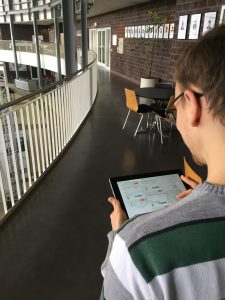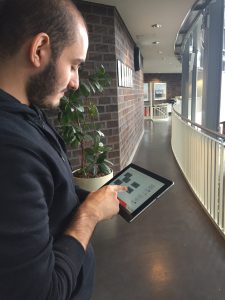Beaconing: Implementing Location-based GLP About Logistics at BIBA
Beaconing: Implementing Location-based GLP About Logistics at BIBA
On 16th November, 2018 we had an implementation session for the Beaconing location-based challenges at BIBA. The “GLP-Logistics: Introduction to Logistics” was designed, tested and implemented by our researcher Anna Barenbrock. The task was completed in two phases. In the first phase, our assistants from the labs tested the GLP which was designed to give an overview of Logistics. In the second phase, we played the game in a class where the students had to follow the gamified lesson path.
The GLP provided an overview of logistics from procurement followed by reception of goods to warehousing. The users had to follow through important steps in these processes and they are presented with the possibilities of new technologies that can be used to ease specific tasks. There were 6 location-based quests to be completed by the players. The user has to physically walk through the different processes (Procurement, goods receipt – taking goods from containers, goods receipt & RFID tags, goods receipt – checking volume/condition of pallet/photo for insurance, warehousing – storage types/shelve systems, warehouse strategies – FIFO/LIFO…) in the BIBA hall. Players receive a map where each station is located in the building and has to decide which is the correct next stop. Each stop is a physical place within a building (QR code or Beacon) and marked with sign naming the specific stop (e.g. Procurement). Prior playing the students receive a map on which each stop is marked, so they know where each stop of the logistic chain can be found. At each correct stop a quest has to be completed. Throughout the procedure, the players had to follow a procedure which was presented as a scenario.
The GLP named “Introduction to Logistics” presented this scenario through a toaster by following different logistics management procedure. There are 6 steps and In each of the steps, players are initially provided with information that is important to learn. In the first step, the players receive an instruction on how to play the game. Then the next step was to learn about procurement of goods. The minigame “Planet Ninja” was designed to make them think about the benefits and risks of different types of procurement options. The following step was to receive the goods that had been ordered in the procurement step. Here, we have introduced the players with a robot that help and support humans in this time consuming, physically demanding and at times risky process of good unloading. A video was showed in order to make them understand the difficulties in designing such a robot. Later on this step, the players had to play the minigame “Drag It”. In the next step, the players explored reception of the goods by checking and identifying the parcels to know what is inside each one of them. This process is usually done with unique bar code (serial shipping container code), RFID chips, etc. Once found, they needed to cross check the received good with the order received to ensure quality and that it was unharmed in the delivery process before warehousing. To complete this stage, the players had to play the minigame “Generic Quiz”. The next step is to learn about different Warehousing systems. They are provided information about manual and automated warehousing and later on, they play another round of “Generic Quiz” minigame designed for this step. In the last step, the players will explore about the warehousing strategies available. FIFO, LIFO, fixed location systems, interleaving, cross distribution, random location systems, etc. are explained to them. Later on, their knowledge is examined through the minigame “Match It”. At the end, the players are informed that the good is in the warehouse and through another GLP they can learn about the delivery process of the goods.
We had 8 student participants from a course taught here at BIBA. They were given a brief on how to play the games and they used android devices to access the game. The POI locations were triggered with QR codes posted in different parts of the designed path of the gameplay. In each POI, students scanned the QR code in order to play the minigame they required to advance further. Later on the discussion part, the students shared their experience about the gameplay. They liked the mobility factor of a location-based quest that is mixed with the reality of the machines in the halls. This provided them with a better way to understand the possibilities of the existing technologies. In their feedback they said that the game mechanics are, quite primal compared to the high-end games available for entertainment. Even after that, they enjoyed the lessons as it bridged the gap between the real-life machineries and textbooks. Overall, this implementation process of the location-based GLP was successful from BIBA perspective.



Work package: WP5/6
Target group: Students as end users, teachers and testers.